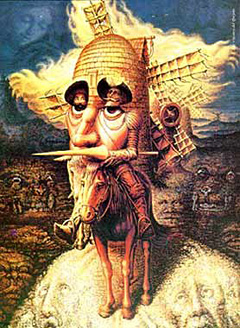 |
 |
 |
 Editorials | July 2007 Editorials | July 2007  
Races of Mexico and the Mexican Genome
 Allan Wall - PVNN Allan Wall - PVNN


| | The many faces of Don Quixote by Octavio Ocampo. |
A friend of mine was visiting in Europe, and there encountered a white tourist. Upon finding she was from Mexico, my friend blurted out “But you don’t look like a Mexican!” So what does a Mexican look like?

Racially speaking, there is great variation among Mexicans.

The Mexican racial breakdown is officially presented as 9% white, 60% Mestizo (Indigenous-European hybrid), 30% Indigenous, and 1% other. The Mestizaje (mixture) of Indians and Spaniards is the principal fact of Mexican racial history. And yet, the details are even more complicated.

The race mixture is so thorough that among Mexico’s Mestizo majority, within the same nuclear family you can find full siblings, with the same mother and father, who are very dark, and very light-skinned.

But it’s not only the skin color. Some Mexicans have white skin but indigenous racial features, while others have dark skin but European facial features.

Then there's eye color. When I first moved to Mexico, it struck me how many Mexicans would make it a point to tell me they had relatives with blue or green eyes. And sure enough, there are blue- and green-eyed Mexicans. Eye color is inherited from both parents. If someone has blue eyes, it’s because both his parents have the genes for it (dominant or recessive).

When the Spaniards arrived in the early 1500s, the nation-state of Mexico did not exist. What is now Mexico was a large landmass inhabited by many ethnic groups. Although they would now all be classified as “Indians” or “Indigenous,” there were physical differences among these groups, just as there are between different people groups in Europe. The Indians of northern Mexico, for one thing, were taller than those of the south, and their heads were shaped a little differently.

Even the Spaniards were not exactly homogeneous. The Iberian Peninsula was a melting pot of many peoples: the mysterious “Iberians,” Phoenicians, Greeks, Celts, Romans, the Teutonic Goths, the Moors and the Jews. Even today, Spain has its sharp regional divisions, and areas where other languages are spoken: Catalonia, Galicia and the Basque Country, where people still speak a language unrelated to any known in the world today.

Besides the Spaniards and the Indians, there were many other groups that contributed to Mexico ’s racial heritage. Blacks from Africa were brought over and settled largely, but not entirely, in coastal areas. After emancipation, they mostly assimilated to the Spanish-speaking majority, but in certain regions you can still detect strong Negroid facial features.

As for the Spaniards, they never stopped coming. Even after independence, Spanish immigrants have continued to emigrate to Mexico, and have assimilated rather easily. But other non-Spanish Europeans have also come to Mexico: Germans, French and Dutch for example.

Middle Eastern immigrants were mostly from Lebanon and Palestine and predominantly from Christian and not Muslim backgrounds. Also, there have been immigrants from East Asia, mostly China and Japan.

Mexico also has a Jewish community. The first Jews to come to Mexico were conquistador Catholics of Jewish background.

Anglo-Saxons too have immigrated, both British and Americans, some of the latter were ex-Confederates who came to Mexico after the Civil War.

All these form part of the Mexican melting pot. And now, with advances in biotechnology, and the breaking of the DNA code, it can be traced through the genes. This was the goal of Mexico’s National Institute of Genomic Medicine, which recently concluded a 2-year study of the Mexican genome, investigating blood samples from a representative sample of Mexicans, half male and half female. The project’s director was Dr. Gerardo Jimenez-Sanchez.

Generally speaking, the genome reseach confirmed what was already obvious about the mixed origins of the Mexican population. The project concluded that Mexicans are the product of the mixture of 35 ethnic groups.

Roughly speaking, the Mexican population was calculated to be 65% indigenous, and 35% non-indigenous (European, African, Asian.)

Of course, there is great regional variety as well. According to the Mexican Genome Project, the population of the northern state of Sonora is 58% European. The population of the Pacific state of Guerrero is 22% African origin.

This is all very interesting, and it has its medical uses as well, since medical predispositions often follow racial backgrounds. As Dr. Jimenez-Sanchez pointed out, medicines that are developed in the U.S. and Europe are not ideal for Mexicans (except for the Euro-Mexicans of course.)
 Allan Wall is an American citizen who has been teaching English in Mexico since 1991, and writing articles about various aspects of Mexico and Mexican society for the past decade. Some of these articles are about Mexico's political scene, history and culture, tourism, and Mexican emigration as viewed from south of the border, which you can read on his website at AllanWall.net. Allan Wall is an American citizen who has been teaching English in Mexico since 1991, and writing articles about various aspects of Mexico and Mexican society for the past decade. Some of these articles are about Mexico's political scene, history and culture, tourism, and Mexican emigration as viewed from south of the border, which you can read on his website at AllanWall.net.

Click HERE for more articles by Allan Wall. | 
 | |
 |



